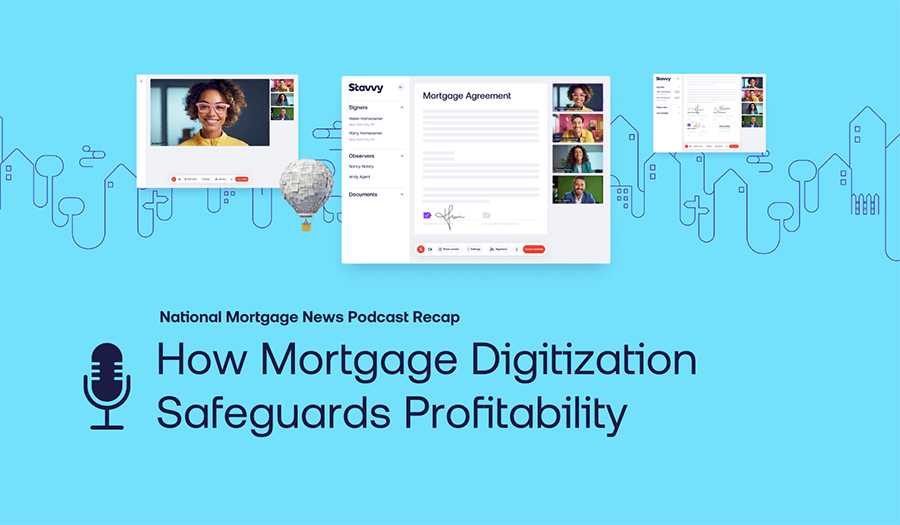With innovation on the rise across industries, residential mortgage lending processes need to keep up.
Historically in mortgage lending, credit scores are the primary measure of someone's eligibility for a loan. However, this practice is problematic because it excludes a wide variety of qualifying individuals. Begging the question: how can we start innovating?
Eric Lapin, Chief Strategy Officer of FormFree, and Stavvy Finside Chats® podcast guest, is no stranger to innovation.
“We're still doing the same thing we have been doing since 1995. I can't believe we're still doing the same thing; the fact that eClosings are still less than 6% is shocking to me.”
- Eric Lapin, FormFree
Heeding Eric’s sentiment, it’s time to change the status quo in the mortgage industry. Residential lenders must consider alternative credit data as a more comprehensive picture of someone's ability and willingness to repay debt.
Eric recently joined Kosta Ligris and Jeremy Potter on Finside Chats® to share his non-traditional mortgage loan solution. Through a completely digital process that uses alternative credit data for mortgage lending, FormFree is handing the power back to consumers. With FormFree, consumers can easily and safely send the necessary financial information directly from their bank account to their lender.
On this episode of Finside Chats®, you’ll learn about:
- The background on direct source data and alternative credit data
- How replacing traditional credit information with direct data benefits mortgage lenders
- The future of alternative credit data in lending
Listen now: How Alternative Credit Data Creates Inclusivity in Mortgage Lending
What are alternative credit data and direct source data?
Direct source data, a type of alternative credit data, is pretty much what it sounds like—comprehensive data and accompanying analytics about a person's financial history directly from the source. When leveraging direct source data in the residential mortgage process, financial information is shared securely and instantly from the applicant’s bank account to the lender.
Eric describes alternative credit data as a more streamlined and fair lending assessment.
“We provide the data and analytics for the consumer to control; they then provide that information to the lender they want to work with. Ability-to-pay analytics are included, and lenders can look for any fair and inclusive lending decisions to be made from that,” said Eric.
Replacing traditional credit information with direct source data
Direct source data better assesses someone's ability to pay than conventional credit scoring alone. Not only does it provide a clear picture of money coming in and going out, but it also provides intelligence on payer behavior.
Eric shares that with FormFree’s more modern approach, everyone can borrow some money and repay it successfully.
“The analytics that we have, utilizing natural language processing, will allow the underwriter to see a myriad of data and really review it as an unbiased approach to lending.”
Studying daily financial activities is a far more accurate indicator of eligibility than a credit score, which can often disqualify someone based on a past financial misstep.
Benefits of alternative credit data for lenders
The democratization of data allows the lender, and all involved parties, to engage directly with a consumer’s financial institution. It eliminates the need for excess due diligence and inter-departmental paper pushing.
“As a lender, I have information generated by a direct source; it comes in complete and has analytics on top of it. Another benefit is the number of touches on the file internally. Instead of [the loan file] going from underwriter to processor to underwriter, you cut those touches by anywhere from 40 to 60%,” said Eric.
Additionally, manufacturing a traditional mortgage loan is expensive. Direct data substantially reduces this cost by streamlining the process and saving time.
"Some of the larger lenders that are going the true digital route are cutting costs by 50%,” said Eric.
Lenders also look to this alternative credit data to create a more inclusive and unbiased lending process. Lenders Mortgage Insurance (LMI) and credit-invisible applicants are finally being considered for a loan, as FormFree acts as a secure intermediary between the consumer and lender.
The future of alternative credit data in lending
Accepting new processes when things have been done a certain way for a long time is hard.
“We're seeing that there's a good core of loan officers that have been around for decades and have done business the way they've always done it and been very successful,” said Eric.
While this may be true, Eric understands the power of innovation and knows that many lenders are ready to look to the future.
“The biggest thing in the industry that we are seeing is digital mortgage technology adoption. And I have to commend the industry for that. In the last year, we’ve seen a lot of movement towards digitization—from income and employment to digital closings and remote online notarization.”
Industry leaders should continue to educate and advocate to help mortgage professionals understand the benefits of digital mortgage technology, like eClosings, remote online notarization (RON), and more.
Learn more about how the  is taking real estate beyond documents.
is taking real estate beyond documents.



![[Webinar Recap] Advancing Your Digital Default Servicing Strategy](https://blog.stavvy.com/hubfs/advancing-your-digital-default-servicing-strategy-blog-recap.png)